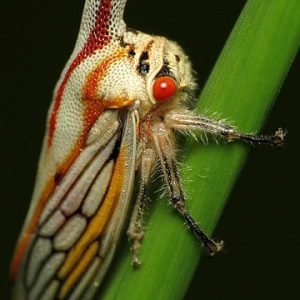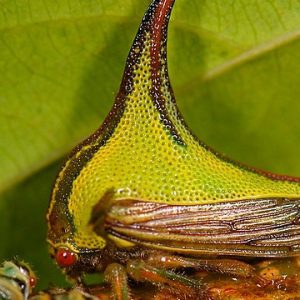In the canvas of Creation, treehoppers emerge as nature’s living masterpieces.
Musa Sattar, London, UK
Deputy Science Editor

© Shutterstock
In the grand tapestry of creation, where every thread tells a story of ingenuity, there exists a group of enchanting creatures that defy conventional understanding:
The treehoppers.
These pint-sized wonders, scientifically known as Membracidae, are not mere insects; they are living canvases of nature’s artistry.
Treehoppers, numbering over 3,200 species, transform their bodies into intricate designs that defy conventional understanding. Their camouflage techniques range from thorn-like protrusions to fantastical extensions, allowing them to blend seamlessly into their arboreal habitats.
Interestingly, these insects have special muscles in their hind legs that allow them to jump rapidly when disturbed. The power generated by these muscles is significantly more than normal muscles. Hence, scientists believe that treehoppers must be using a ‘power amplification mechanism in a catapult-like action.’
Their most prominent feature is the variety of oddly shaped helmets which grow from their backs. According to Benjamin Prud’homme, of the Institut de Biologie du Développement de Marseille-Luminy, scientists don’t yet know the function of the helmet, but they appear to be like they mimic the environment. But going beyond static mimicry, treehoppers can actively alter their appearance based on environmental cues, showcasing a dynamic approach to survival that reflects the evolutionary mastery embedded in their genetic code. Some treehopper species sport thorn-like protuberances, camouflaging seamlessly with the branches they inhabit. Others mimic blossoms, blending into the foliage like living petals or resembling seeds, leaves or thorns that help in camouflage. They are also capable of mimicking other organisms that predators might avoid, such as wasps, ants or deadly insect-killing fungal fruiting bodies.

© Shutterstock
The ingenuity extends to stunning extensions that defy conventional insect morphology, and challenge our perception of what an insect should be. It’s as if each species has its own signature design, a testament to the boundless creativity embedded in the blueprint of nature.
Beyond their captivating appearance, treehoppers engage in a symphony of communication through vibrational signals transmitted through the plants they inhabit. They use branches for communication, with sounds and vibrations totally inaudible to humans. They vibrate their abdomens against stems, creating messages that travel up to two meters through the tree to their fellow treehoppers. Scientists believe that they use the sounds to warn others about predators, and even to signal to a potential mate. This ability to tap into their surroundings and utilise it as a medium for communication showcases the interconnectedness of life in the natural world.
Likewise, treehoppers have great relationships with other creatures like ants, wasps, and even geckos, with whom they communicate. One such example is found in their relationship with stingless bees, which protect the treehopper nymphs by knocking any intruder off the branch. In return for this favour, the treehoppers reward them with a gift of honeydew. The bee tickles the rear end of the nymph with its antennae and receives the honeydew.
Astonishingly, treehoppers further illuminate the marvels of their existence when it comes to their geographic distribution. From rainforests to deserts, treehoppers have adapted to a wide range of environments, showcasing the resilience and versatility of their species.

© Shutterstock
In terms of reproduction, female treehoppers display intriguing maternal care. They often guard their eggs and may even produce a substance that serves as a protective shield for the developing nymphs. This nurturing behaviour adds another layer to the complex web of interactions within treehopper communities.
As we delve into the enchanting world of treehoppers, it becomes evident that their flawless design and intricate behaviours raise thought-provoking questions about the orchestrator of this symphony – a Supreme Creator. The level of detail, diversity, and adaptability displayed by treehoppers suggests a level of artistry that surpasses the limitations of blind evolution.
As Sir David Attenborough said, ‘this tiny insect [treehoppers] turns out to be not just a good mimic, but also an accomplished interspecies communicator.’
As we ponder the depths of this living artistry, the question remains – could the brilliance of treehoppers be a manifestation of a higher intelligence, an unseen artist weaving a masterpiece that transcends our understanding? The awe-inspiring beauty and complexity of these tiny creatures invite us to explore, appreciate, and reflect on the symphony of creation that unfolds around us.
Further Reading:
https://www.sciencedirect.com/topics/agricultural-and-biological-sciences/treehopper
Prud’homme, B., Minervino, C., Hocine, M. et al. ‘Body plan innovation in treehoppers through the evolution of an extra wing-like appendage.’ Nature: vol.473, 83–86 (2011). https://doi.org/10.1038/nature09977
https://www.nationalgeographic.com/magazine/article/treehoppers-could-be-worlds-weirdest-insects
https://www.science.org/content/article/treehopper-camouflage-derives-ancestral-wing




Add Comment